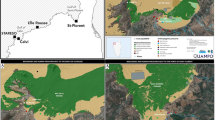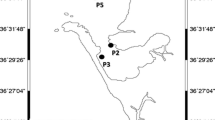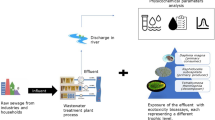Abstract
Purpose
In France, contaminated seaport sediments cannot be discharged into the sea according to recent regulation. Hence, they must be managed on land. Among the solutions identified, that of filling terrestrial quarries located in the littoral zone is one of the most promising. However, this requires developing a methodology for ecological risk assessment; which was the aim of the SEDIGEST research program. In the present study, we report the results of toxicological impacts of three sediments on aquatic ecosystems close to a quarry. These results were used to formulate a risk assessment methodology.
Materials and methods
The ecotoxicological approach was based on laboratory microcosm assays applied to leachates obtained from the sediments. The microcosms contained synthetic water and sediment and five pelagic (micro-algae, duckweeds and daphnids) and benthic (chironomids and amphipods) freshwater species. The biota were exposed for 3 weeks to a range of leachate concentrations; metals were monitored in the water column and the effects (i.e. mortality, growth inhibition and midge emergence) were measured.
Results and discussion
The results showed an absence of acute toxicity at concentrations of <10% (v/v) but sublethal effects for concentrations between 1 and 10%. Given the complex nature of the leachates, it was difficult to determine the factors of toxicity. Metals, especially Cu, might have been responsible for some of the effects on the amphipods.
Conclusions
Future quarries filled with seaport sediments might emit pollutants to aquatic ecosystems in their vicinity, and risk assessors should ensure that predicted environmental concentrations of leachates are below the maximum leachate concentration acceptable for the whole ecosystem; for example, by multiplying the concentration safe for the microcosm organisms by a factor of 10.




Similar content being viewed by others
References
AFNOR (1993) Qualite de l’eau-essai d’inhibition de la croissance des algues d’eau douce avec Scenedesmus subspicatus et Selenastrum capricornutum. NF T 90-304. Technical Report, Paris, France
AFNOR (1996) Essais des eaux-détermination de l’inhibition de la croissance de Lemna minor. XP T 90-337. Technical Report, Paris, France
AFNOR (1999) Qualité de l’eau-dosage par chromatographie ionique des ions Li+, NH4 +, K+, Mn2+, Ca2+, Mg2+, Sr2+ et Ba2+ dissous-méthode applicable pour l’eau et les eaux résiduaires. NF T 90-048. Technical Report, Paris, France
AFNOR (2000) Qualité de l’eau-Eaux douces, eaux résiduaires. Ammonium. Dosage par spectrométrie visible. NF T 90-015-1 Technical Report, Paris, France
Andersen HV, Kjølholt J, Poll C, Dahl SØ, Stuer-Lauridsen F, Pedersen F, Bjørnestad E (1998) Environmental risk assessment of surface water and sediments in Copenhagen harbour. Water Sci Technol 37:263–272
Clément B, Cadier C (1998) Development of a new laboratory freshwater/sediment microcosm test. Ecotoxicology 7:279–290
Davoren M, Ní Shúilleabháin S, Hartl MGJ, Sheehan D, O’Brien NM, O’Halloran J, Van Pelt FNAM, Mothersill C (2005) Assessing the potential of fish cell lines as tools for the cytotoxicity of estuarine sediment aqueous elutriates. Toxicol in Vitro 19:421–431
De Schamphelaere K, Heijerick DG, Janssen CR (2002) Refinement and field validation of a biotic ligand model predicting acute copper toxicity to Daphnia magna. Comp Biochem Physiol C Toxicol Pharmacol 133:243–258
ECB (2003) Technical Guidance Document (TGD) in support of Commission Directive 93/67/EEC on Risk Assessment for new notified substances, Commission Regulation (EC) No 1488/94 on Risk Assessment for existing substances and Directive 98/8/EC of the European Parliament and of the Council concerning the placing of biocidal products on the market. European Chemical Bureau, Ispra, Italy, p. 1044
Grosdemange D, Leveque F, Drousie D, Aqua JL, Méhu J, Bazin C (2008) The SEDIMARD project: presentation and results. International Symposium on Sediment Management I2SM, Lille, 10-12 July 2008, pp 181–186
IFREMER (2001) Dredging and marine environment, pp 20. http://envlit.ifremer.fr/var/envlit/storage/documents/dossiers/bioevaluation/site/index.htm
Ingersoll CG, Haverland PS, Brunson EL, Canfield TJ, Dwyer FJ, Henke CE, Kemble NE, Mount DR (1996) Calculation and evaluation of sediment effect concentration for the amphipod Hyalella azteca and the midge Chironomus riparius. USEPA Report 905-R96-008, United States Environmental Protection Agency, Chicago, USA
ISO (1989) Qualité de l’eau—Détermination de l’inhibition de la mobilité de Daphnia magna Straus (Cladocera, Crustacea). ISO 6341
ISO (2004) Qualité de l’eau—Dosage de composés organostanniques sélectionnés - Méthode par chromatographie en phase gazeuse. ISO 17353
ISO (2005) Qualité de l’eau—Détermination des hydrocarbures aromatiques polycycliques (HAP)—Partie 1: Dosage de six HAP par chromatographie de haute performance sur couche mince avec détection fluorimétrique à la suite d’une extraction liquide-liquide. ISO/WD/7981
ISO (2007) Qualité de l’eau–Dosage des anions dissous par chromatographie des ions en phase liquid—Partie 1: Dosage du bromure, chlorure, fluorure, nitrate, nitrite, phosphate et sulfate. ISO 10304-1:2007
ISO (2009) Qualité de l’eau—Dosage d’éléments choisis par spectroscopie d’émission optique avec plasma induit par haute fréquence (ICP-OES). NF EN ISO 11885
Kocan RM, Sabo KM, Landolt ML (1985) Cytotoxicity/genotoxicity: the application of cell culture techniques to the measurement of marine sediment pollution. Aquatic Toxicol 6:165–177
Lau MM, Rootham RC, Bradley GC (1993) A strategy for the management of contaminated dredged sediment in Hong Kong. J Environ Management 38:99–114
MacDonald DD, Ingersoll CG, Berger TA (2000) Development and evaluation of consensus-based sediment quality guidelines for freshwater ecosystems. Arch Environ Contam Toxicol 39:20–31
Mamindy-Pajany Y, Libralato G, Roméo M, Hurel C, Losso C, Ghirardini AV, Marmier N (2009) Ecotoxicological evaluation of Mediterranean dredged sediment ports based on elutriates with oyster embryotoxicity tests after composting process. Water Res 44:1986–1994
Martínez-Jerónimo F, Martínez-Jerónimo L (2007) Chronic effect of NaCl salinity on a freshwater strain of Daphnia magna Straus (Crustacea: Cladocera): a demographic study. Ecotoxicol Environ Safety 67:411–416
MATE (2000) Arrêté du 14/06/00 relatif aux niveaux de référence à prendre en compte lors d’une analyse de sédiments marins ou estuariens présents en milieu naturel ou portuaire. JO no. 184 du 10 août 2000
MEEDDAT (2008) Circulaire du 04/07/08 relative à la procédure concernant la gestion des sédiments lors de travaux ou d’opérations impliquant des dragages ou curages maritimes et fluviaux. BO no. 2008/15 (France)
OECD (1993) Algal growth inhibition Test 201, OECD guideline for testing of chemicals. Draft proposal for a guidance document, Freshwater lentic field tests. Organization for Economic Cooperation and Development, Paris, France
RPA (2005) Risk assessment studies on targeted consumer applications of certain organotin compounds—final report prepared for the European Commission, 174 p. http://ec.europa.eu/enterprise/sectors/chemicals/files/studies/organotins_3rd_report_16_sept_2005_en.pdf
Sarma SSS, Nandini S, Morales-Ventura J, Delgado-Martinez I, Gonzalez-Valverde L (2006) Effects of NaCl salinity on the population dynamics of freshwater zooplankton (rotifers and cladocerans). Aquat Ecol 40:349–360
Schuytema GS, Nebeker AV, Stutzman TW (1997) Salinity tolerance of Daphnia magna and potential use for estuarine sediment toxicity tests. Arch Environ Contam Toxicol 33:194–198
SEDIGEST (2011) Programme de recherche ANR SEDIGEST. In: ENTPE (ed) Vaulx en Velin. http://www.sedigest.org/
Srut M, Traven L, Stambuk A, Kralj S, Zaja R, Micovic V, Klobucar GIV (2010) Genotoxicity of marine sediments in the fish hepatoma cell line PLHC-1 as assessed by the Comet assay. Toxicol in Vitro 25:308–314
Suedel BC, Rodgers JH Jr, Deaver E (1997) Experimental factors that may affect toxicity of cadmium to freshwater organisms. Arch Environ Contam Toxicol 33:188–193
Triffault-Bouchet G, Clément B, Blake G (2005a) Assessment of contaminated sediments with an indoor freshwater/sediment microcosm assay. Environ Toxicol Chem 24:2243–2253
Triffault-Bouchet G, Clément B, Blake G (2005b) Ecotoxicological assessment of pollutant flux released from bottom ash reused in road construction. Aquat Ecosyst Health 8:405–414
USEPA (2000) Methods for Measuring the Toxicity and Bioaccumulation of Sediment-associated Contaminants with Freshwater Invertebrates, Second Edition. US EPA Report 600/R-99/064, United States Environmental Protection Agency, Chicago, USA
Verrhiest G, Cortes S, Clément B, Montuelle B (2002) Chemical and microbial changes during laboratory conditioning of formulated and natural sediments. Chemosphere 46:961–974
Williams WD (1998) Salinity as a determinant of the structure of biological communities in salt lakes. Hydrobiologia 381:191–201
Wong YS, Tam NFY, Lau PS, Xue XZ (1995) The toxicity of marine sediments in Victoria Harbour, Hong Kong. Mar Pollut Bull 31:464–470
Acknowledgments
The authors thank all the teams that participated in the “SEDIGEST” research program focusing on the assessment of ecological risks linked to filling-in coastal quarries with treated, dredged harbour sediments and which belonged to the following organisations: ENTPE, INSA de Lyon, BRGM, INSAVALOR, INERIS, IN VIVO Environment, CETMEF, CG 83, CG 29 and EEDEMS. The details of all the participants in the program can be consulted on the internet site www.sedigest.org). The authors also thank the French National Research Agency (ANR) and the “AXELERA”, “Mer PACA” and “Mer Bretagne” clusters respectively for their financial assistance and the labelling assigned to the SEDIGEST project.
Author information
Authors and Affiliations
Corresponding author
Additional information
Responsible editor: Wolfgang Ahlf
Rights and permissions
About this article
Cite this article
Clément, B., Guillen, B., Xu, J. et al. Ecotoxicological risk assessment of a quarry filling with seaport sediments using laboratory freshwater aquatic microcosms. J Soils Sediments 14, 183–195 (2014). https://doi.org/10.1007/s11368-013-0782-3
Received:
Accepted:
Published:
Issue Date:
DOI: https://doi.org/10.1007/s11368-013-0782-3




